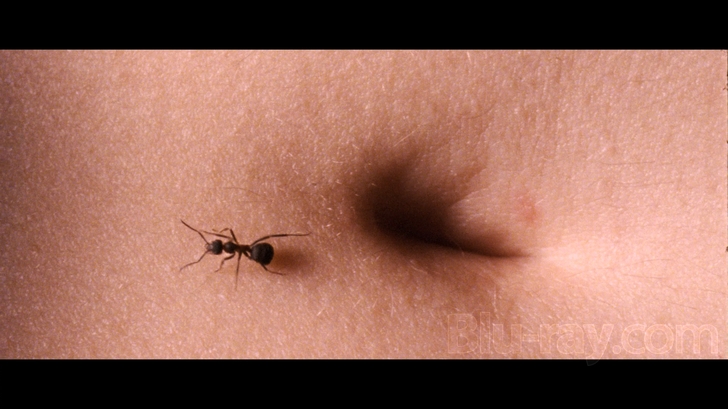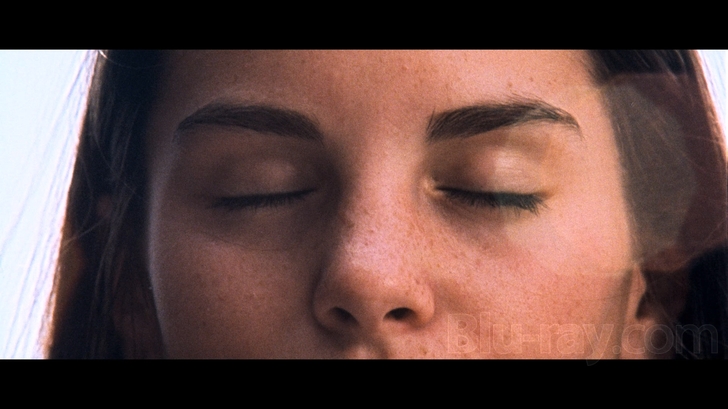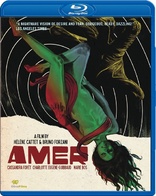Amer Blu-ray Movie
HomeAmer Blu-ray Movie 
Olive Films | 2009 | 90 min | Not rated | Oct 04, 2011Movie rating
6.8 | / 10 |
Blu-ray rating
| Users | 0.0 | |
| Reviewer | 4.5 | |
| Overall | 4.5 |
Overview
Amer (2009)
Three key moments, all of them sensual, define Ana's life. Her carnal search sways between reality and colored fantasies becoming more and more oppressive. A black laced hand prevents her from screaming. The wind lifts her dress and caresses her thighs. A razor blade brushes her skin, where will this chaotic and carnivorous journey leave her?
Starring: Marie Bos, Harry Cleven, Delphine Brual, Jean-Michel Vovk, Bernard MarbaixDirector: Helene Cattet, Bruno Forzani
| Foreign | 100% |
| Horror | 86% |
| Drama | 33% |
| Psychological thriller | 21% |
| Thriller | Insignificant |
Specifications
Video
Video codec: MPEG-4 AVC
Video resolution: 1080p
Aspect ratio: 2.35:1
Original aspect ratio: 2.39:1
Audio
French: DTS-HD Master Audio 5.1 (48kHz, 16-bit)
French: DTS-HD Master Audio 2.0
Subtitles
English
Discs
25GB Blu-ray Disc
Single disc (1 BD)
Playback
Region free
Review
Rating summary
| Movie | 4.5 | |
| Video | 4.0 | |
| Audio | 4.5 | |
| Extras | 3.0 | |
| Overall | 4.5 |
Amer Blu-ray Movie Review
Bitter. Sweet.
Reviewed by Jeffrey Kauffman October 3, 2011Giallo is an Italian word meaning “yellow,” a term ported over to a genre of 1970s Italian horror cinema because the source novels many of the films were based on were originally published with saffron colored covers. It’s somewhat ironic that yellow is one of the few colors not exploited in Amer, a really stunning French-Belgian film from 2009 that seeks to rethink the 1970s giallo ethos in a sort of post-modern, abstract environment. The film is discursive, opaque, never completely clear and therefore will not be to everyone’s taste. Playing out with just a handful of spoken dialogue lines, the film charts the course of its female protagonist, Ana, shown at three critical moments in her life. As a young girl, she is haunted by the death of an elderly man one assumes must be her Grandfather (nothing is explained definitively in Amer, which is either part of its allure or is part of its maddening frustrating propensity, depending on your point of view). As an adolescent, she seems involved in a sexual competition with her mother, not so subtly provoking a biker gang with whom she comes into contact. As an adult, she is returning to her family home as she is lasciviously eyeballed by her taxi driver on the way there and then is tormented by a mysterious figure once she gets back to her house. Amer is a film which exults in Eisensteinian montage. It’s also an epic trek through brilliant editing techniques, and a brightly lit, abundantly colorful revisionist look at abstract expressionism. This is a film which wears Ana’s every emotion on its filmic sleeve, and as such it is like taking a Fantastic Voyage journey into the psyche of a literally and figuratively haunted female. One is never quite sure what is real and what is imagined, what is waking life and what is dream (or nightmare), and what, frankly, is life and what is death. Amer is certainly one of the most challenging viewing experiences in recent memory, because it fully engages the viewer, insisting that the audience formulate the story as much as the filmmakers themselves.

The problem with pastiche is that the referent often outshines the reference. Amer’s co-directors Hélène Cattet and Bruno Forzano make no bones about their film being an homage to the likes of Luis Buñuel, Dario Argento and Mario Bava, but the two both figuratively and literally dissect the genre, deconstructing the florid hyperbole of the antecedents to create something new and vibrantly innovative. The film references earlier iconic images (sliced eyeballs, insects climbing out of body orifices) that owe as much to surrealism and Dadaism as they do to traditional giallo, but within the context of Amer, the images don’t seem warmed over copies and instead are fascinatingly new and compelling.
The film is divided into three sections, one for each time period of Ana’s life, and each section has its own clear subtext even if some of the details are left for the viewer to fill in for themselves. An unspoken conflict between Ana and her mother is almost immediately established in the first sequence, one which never makes clear who the mysterious woman seemingly haunting Ana is (is it the Grandmother? a nanny? a housekeeper?) or who in fact the dead man in the parlor is. All that’s clear is this is a house that is haunted by more than just a dead man or a mysterious woman. It is haunted by the imagination of a young girl who sees, who watches compulsively, as if she herself is viewing a movie. The film in fact repeatedly exploits the image of the eye. Eyes peer through keyholes. Eyes grab stolen glances in rear view mirrors. Everywhere there are eyes, penetrating back right at the audience as if to say, “See? You’re not the only one watching.”
As opaque as much of Amer is, what’s intriguing about the film is how abundantly clear so much of it is, especially with so little dialogue. There are obviously aspects the directors don’t want to be understood, at least not rationally, but other elements are completely comprehensible on both a conscious and perhaps even more importantly a subconscious level. The child Ana’s fear and superstition come through loud and clear in the first section. Adolescent Ana’s budding sexuality is brilliantly portrayed with just a few shots of her skirt billowing in the breeze. And a conflicted, but sexually mature, older woman finds that seduction can be a dangerous game in the final sequence. Amer communicates almost wholly through image (though an extremely evocative soundtrack, much of it culled from actual source cues lifted from 1970s giallo films, helps immeasurably). This visual aspect is only too appropriate for a film which emphasizes eyes so continually.
This is a film which also isn’t above the tantalizing tease. Ana herself is a flirt. She flirts with death. She flirts with danger. The film itself flirts with any number of ideas, both profound and trivial, without coming right out and openly discussing or portraying them. Like stolen glances snatched between illicit lovers, Amer offers glimpses at meaning without ever clearly delineating what that meaning is. That will no doubt drive some viewers crazy. For others it will offer an intriguing opportunity to become part of a film’s narrative arc, making the Idea concrete by virtue of their own participation.
Amer Blu-ray Movie, Video Quality 

Amer is presented on Blu-ray courtesy of Olive Films with an AVC encoded 1080p transfer in 2.35:1. Olive's previous Blu-ray slate has been limited mostly to older Paramount titles, and the label has done a fine job in releasing prints with little to no digital manipulation, though that has also often meant less than stellar source elements. There is little doubt that Amer is the sharpest looking Blu-ray yet released by Olive, no doubt due at least in no small part to the recent vintage of the film. This is a ravishingly beautiful film a lot of the time, courtesy of some extremely expressive cinematography by Manu Dacosse, and the Blu-ray reproduces the changing color spectrums effortlessly. Fine detail is abundant, the image is sharp and clear, and though many sequences are bathed in darkness, crush is minimal and shadow detail is strong. One of the best things about the film is the distinctive filtering which is employed, often bathing whole scenes in deep blues or reds, and that element is presented extremely well on the Blu-ray, with brilliantly saturated hues.
Amer Blu-ray Movie, Audio Quality 

It wasn't until years after I had first fallen in love with Italian cinema, especially the work of Fellini, that I found out that virtually all Italian films up through the sixties (and even beyond), at least those done at Cinecitta, were filmed silently and then all sound was added later. I suddenly realized at least one element that contributed to many of these films' (and especially Fellini's) surreality, that slight but noticeable disconnect between image and sound. That same feeling is very much on display in Amer, whose Blu-ray offers two lossless tracks, both in French, one a DTS-HD Master Audio 5.1 surround mix and the other a stereo DTS-HD Master Audio 2.0. The film has virtually no dialogue, and the rest of the soundtrack is an assemblage of sometimes bizarre sound effects (heavy breathing and the like) mixed with archival soundtrack music from actual giallos, including work by composers Stelvio Capriani, Bruno Nicolai and none other than Ennio Morricone. The images are spectacularly evocative enough in Amer, but combined with the sometimes anachronistic soundtrack the film becomes like a waking dream, almost hallucinatory in its power, and the brilliance of the lossless audio contributes in no small measure to that slightly unreal feeling. Most of the music stems are in excellent shape (though astute listeners will hear a very slight change in speed right at the beginning of the first cue, perhaps done intentionally). Surround channels are artfully used to immerse the listener in the unreality. Fidelity is strong and dynamic range is exceptional.
Amer Blu-ray Movie, Special Features and Extras 

- 5 Short Films by Cattet and Forzani is an intriguing collection of films made between 2000 and 2009, some in the filmmakers' own apartment. These all show an early interest in minimal dialogue and montage and editing techniques, as well as soundtracks which are not inherently linked to the onscreen action. The films included are Chaos (SD; 3:02), Chambre Jaune (SD; 7:38), Le Fin de Notre Amour (SD; 9:55), L'Etrange Portrait de La Dame en Jaune (SD; 5:34) an Santos Palace (SD; 15:00).
- Trailer 1 (HD; 1:03)
- Trailer 2 (SD; 00:50)
- Teaser (SD; 00:27)
Amer Blu-ray Movie, Overall Score and Recommendation 

Amer means "bitter" in French, and there is a certain tartness to the imagery and soundtrack throughout this film, a bitterness which requires the viewer (and listener) to actually engage with what's being depicted rather than simply passively assimilating everything. This is certainly not a mainstream film by any stretch of the imagination, but for those who want to experience something new and innovative but still tied to a specific filmic tradition, I personally can't think of a sweeter experience than Amer. Highly recommended.
Similar titles
Similar titles you might also like

The Strange Color of Your Body's Tears
L'étrange couleur des larmes de ton corps
2013

Raw
Grave
2016

Bloodlust
Mosquito - Der Schänder
1977

The Secret of Dorian Gray
Il Dio Chiamato Dorian
1970

The Innocents
De uskyldige
2021

House on Straw Hill
Exposé / Trauma
1976

Deathdream 4K
Dead of Night
1974

Evolution
2015

Black Candles
Los ritos sexuales del diablo
1982

The Living Dead Girl
La morte vivante
1982

Trauma
2017

Death on the Beach
Muerte en la playa
1991

Luz
2018

The Perfume of the Lady in Black
Il profumo della signora in nero
1974

Killer Nun
Suor Omicidi
1979

Death Walks at Midnight
Special Edition | La morte accarezza a mezzanotte
1972

Death Smiles on a Murderer
La morte ha sorriso all'assassino
1973

Bedevilled
2010

The Bird with the Crystal Plumage 4K
L’uccello dalle piume di cristallo
1970

The Wailing 4K
곡성 / Goksung
2016
